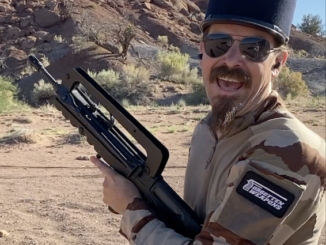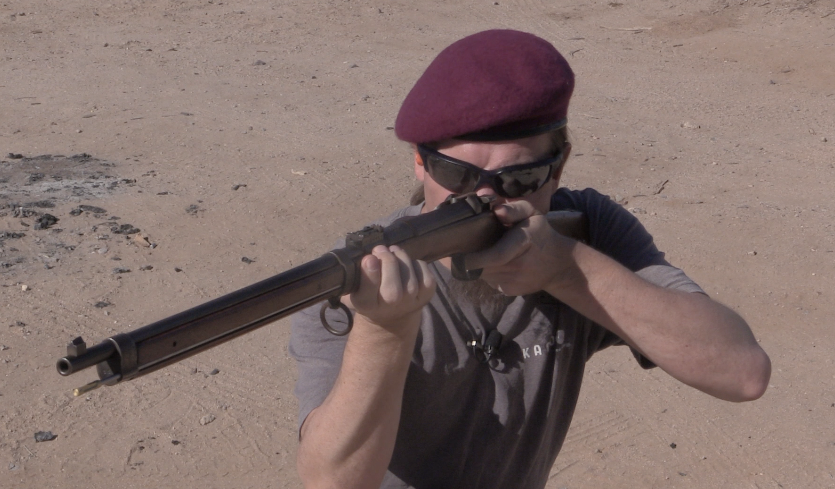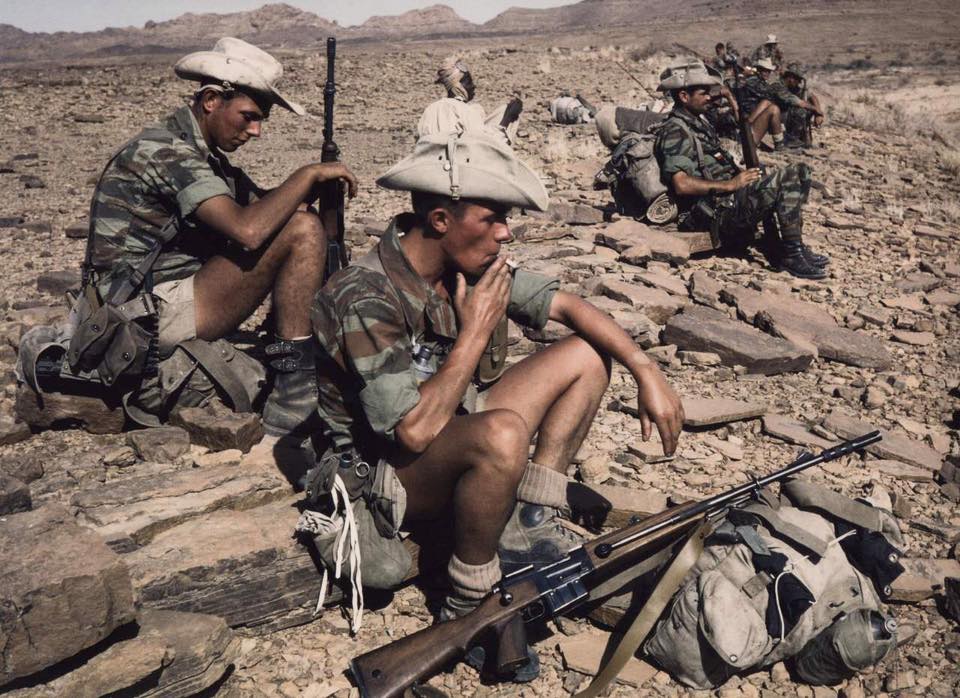In the early years of the 20th century, before the Great War tempered society’s interest in the martial arts, dueling came into the popular vogue. Not the lethal kind, but rather a more sporting style using pistols firing wax balls instead of lead bullets. It was even demonstrated at the 1908 Olympics (although not made an official part of the Games, as some claim).
Today we are at the Institute of Military Technology looking at a beautiful early 1900s set of Lepage Brothers wax-ball dueling pistols made in Paris, along with their specialty ammunition and protective gear. For the record, we did try firing these, and found that the primer caps were all sadly destroyed by time and would not fire. A shame, because I was hoping to bring you a proper duel between myself and the IMT’s Curator!
Anyway, the sport bears quite a lot of similarity to today’s innovative new (*cough*) trend in force-on-force firearms training, just styled more like fencing than a HEMA melee. The protective gear was just what you would expect today – a handguard to protect the knuckles and a mask to protect the head, with a clear solid visor over the eyes and a metal shield to protect the mouth. Add a heavy coat, and you’re all ready to go!




Extremely nice content, as always! I don’t even have to hope that 2018 is going to be a great year for you, I KNOW 2018 is going to be another great year for you. 🙂
Whatever YouTube may throw at you, you have loyal viewers who will stick with you.
2018 is gonna be a blast! (literally)
“Ready, aim, fire!” This isn’t a quick draw duel, for those who don’t get the idea. And use of dyed wax munitions for training makes plenty of sense if one has enough logistical support to justify the expenses. Just remember to wear body armor, because impacts still hurt. And thankfully for us real terrorists almost never bother with training munitions, because the stuff is pretty expensive (crafting special training weapons and ammunition costs more material and research than live ammunition training). Did I mess up?
With very little effort you could get these working again
Just give some context, duels weren’t illegal but after 1903 killing someone in a duel was punishable by death. That could explain why they’d come up with those around 1905.
Would also explain why these look like real dueling pistols with an add-on handguard. A cool way to use up parts in inventory.
My brother and I used to do this with single-shot .22’s. we’d pull the bullets with pliers, dump the powder, then press the primed case into a pan of candle wax. They were incredibly inaccurate, but it made it safe to shoot in our back yard.
By the way, wax bullets generally won’t cycle semi automatic handguns. Revolvers will work.
Good fun!
I recall reading somewhere that “dueling” with these pistols was either planned to be, or in fact very briefly was an Olympic sport before WW I.
“Olympic”
Historical tidbit:
Tug of war was one of disciplines of Olympics from 1900 onward
https://en.wikipedia.org/wiki/Tug_of_war_at_the_Summer_Olympics
I thought about that too, as Ian mentioned the fencing masks.
What else then a duelling sport would fencing be ?
But duelling with pistols would be possibly somewhat boring and much less sporting then fencing. No wonder that it don’t get far.
Took a long time to the more fun paint ball shooting.
Cousin and I tried something similar. Dad was a big Bill “Trooper” Jordan disciple, and had a bunch of .38 Special cases with the flash hole drilled out. Shove the case into a block of paraffin wax, seat a primer, and you got a great practice round to practice your quick-draw. Short version is, we invented our own version of “Force On Force” training, and I ended up taking one in the back of the thigh that left such a nasty bruise I couldn’t hide it. Got caught because we didn’t realize how much wax would be left in the barrel, and failed to get the guns clean enough to get by the old man.
NOT RELATED TO TOPIC SO IGNORE IF YOU WISH
Drawings of Salvator-Dormus automatic pistols, apparently from patent drawings are available here (click to enlarge): http://historypistols.ru/blog/pistolety-pod-unitarnyj-patron-avtomaticheskie/samozaryadnye-pistolety-salvatora-dormusa-obrazca-1891-1897-goda-salvator-dormus-semiautomatic-pistol-model-1891-1897/
Thank you, an interesting early pistol.
According to old Manufrance catalogs, doctor Devillers was the inventor of the “inoffensive” (as called in period ads) wax bullet.
The 11mm cartridge is based on the 44 Russian, a popular target caliber of the time.
To put the cost of ammo in perspective, in 1912 the cased pair of pistols cost about 400 francs, an uncased pair between 150 and 200 francs according to finish. And a modified 1892 ordnance revolver with the hand guard cost about 60 francs.
For 60 francs, there was also a Carbona pistol shooting the 8mm wax bullets. The Carbona was an early system of CO2 target rifles and pistols which used a detachable gas bottle that needed to be sent back to the factory for refilling.
Beside the masks, those catalogs also offered the padded overcoats, there was even a less expensive half overcoat because you were required to protect only your body side facing your opponent.
A forerunner of paintball?
;-0
cheers
eon
Possibly, but sporting duel is still sport, not group fun. Paintball loosely simulates a mock firefight, but duels are duels.
“A forerunner of paintball?”
Rather not, in late 19th century France, duel could happen if some dispute could not be solved in other way or after serious insult.
In late 19th century France it was civilized and formalized and death of opponent was never aim (condition of victory) – duels require presence of seconds and everything was arranged to make equal chances for both sides. Time to make shot when using pistol was limited, distance must be agreed by both sides and so on.
Wikipedia query duel has photo of wax-bulleted duel: https://en.wikipedia.org/wiki/Duel#Olympics
As curiosity: last duel in France was 1967 and was filmed see:
https://www.youtube.com/watch?v=e68nuAcSuWQ
Russian writer M.Yu.Lermontov was killed in duel (1841)
Who insulted Lermontov to that degree? Or did he offend someone that badly?
Fatal (for Lermontov) duel was against N.S.Martynov
https://en.wikipedia.org/wiki/Mikhail_Lermontov#Death
But if the wax bullets was used for a non lethal duel how would someone decide who’s the winner ?
You just can tell witch shot would have been possibly “more lethal” but probably not who shoot first for example.
Then you could also do a cardboard-target shooting instead.
“(…)not who shoot first for example.”
Then used rules, says that shots were fired sequentially
https://www.geriwalton.com/french-dueling-codes-for-swords-pistols-and-sabers/
Rule 51. The combatants must be placed on the ground by their respective seconds ; if thirty-five paces have been fixed upon, the offended party has the right to the first fire ; if only fifteen paces are marked, the first fire must be decided by drawing lots.
For obviously less-than-lethal firearms training that involves actual cartridge-firing weapons crafted specifically for such an activity, how would a dye-marker cartridge compare to a regular lethal counterpart in terms of manufacturing costs? Would the force-on-force style systems be considered too expensive for ordinary people? And if so, how expensive is it to craft wax blanks for ordinary handguns other than revolvers?
“(…)how expensive is it to craft wax blanks for ordinary handguns(…)”
For automatic pistol: I doubt if it can be done: keeping reliable cycling without altering weapon itself. Wax variant of cartridge for obvious weapon will have lower momentum and will react with barrel differently (different friction). Limited muzzle velocity and projectile mass, would probably be okay for blow-back operation, however it would need lighter slide and/or other spring probably.
Alternatively you might chose to go with repeating non-automatic pistol, like https://www.forgottenweapons.com/gaulois-palm-pistol-at-ria/
such design might require short cartridges, but if you want only priming compound and projectile it is not problem.
Those primers look like the .22 cal. shotgun primers that one can still find at french gun shows
I believe Gevelot was still making them in the 1960’s
This sport was just phasing out in the early 50’s; I remember reading an article about it in the old True Magazine.
Seriously classy old side-lever shootin’ irons! I want one chambered for .357 mag! And another in .44 mag; why do this by halves. And then maybe one or two carbines built the same way, with beautiful checkered fore ends. Yes, let’s see some old-fangled style out at the range!
Sometime around age ten I possessed a toy muzzle-loading side-hammer percussion pirate pistol that fired cork balls. Powered by an ordinary cap-gun sticky paper cap placed on what looked like a percussion-gun nipple. Smoothbore and low-velocity but cool to have except for the antique appearance.
So if the gun set was 400 francs back then, what did dinner cost? Rent? A night at the Follie Bergere? A glass of vin blanc and an omelet? Value is so relative …